Intel SSD 530 (240GB) Review
by Kristian Vättö on November 15, 2013 1:45 PM EST- Posted in
- Storage
- SSDs
- Intel
- Intel SSD 530
Random Read/Write Speed
The four corners of SSD performance are as follows: random read, random write, sequential read and sequential write speed. Random accesses are generally small in size, while sequential accesses tend to be larger and thus we have the four Iometer tests we use in all of our reviews.
Our first test writes 4KB in a completely random pattern over an 8GB space of the drive to simulate the sort of random access that you'd see on an OS drive (even this is more stressful than a normal desktop user would see). I perform three concurrent IOs and run the test for 3 minutes. The results reported are in average MB/s over the entire time. We use both standard pseudo randomly generated data for each write as well as fully random data to show you both the maximum and minimum performance offered by SandForce based drives in these tests. The average performance of SF drives will likely be somewhere in between the two values for each drive you see in the graphs. For an understanding of why this matters, read our original SandForce article.
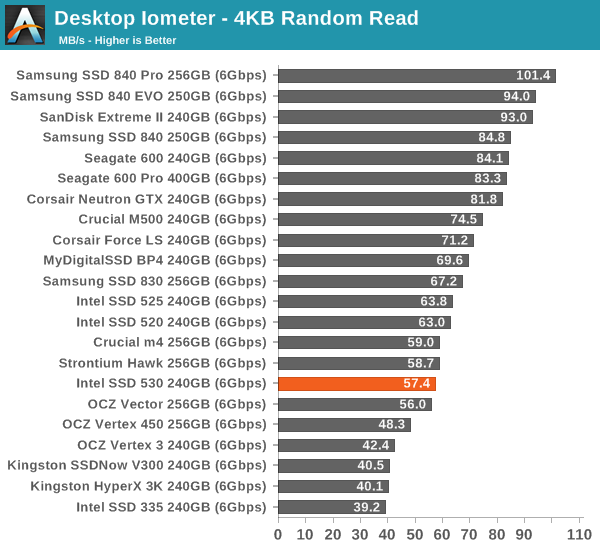
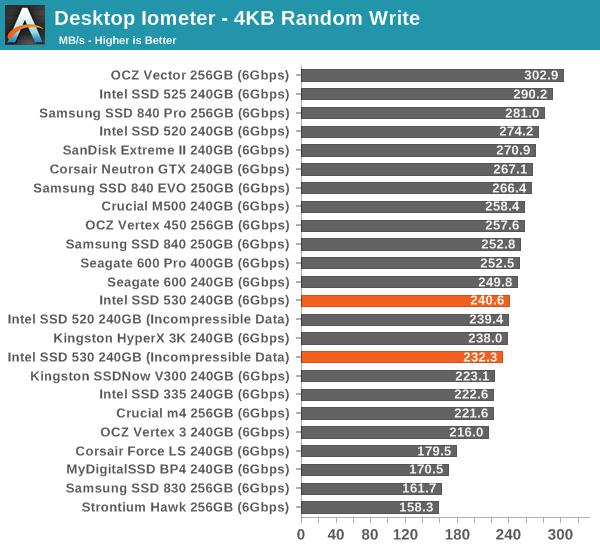
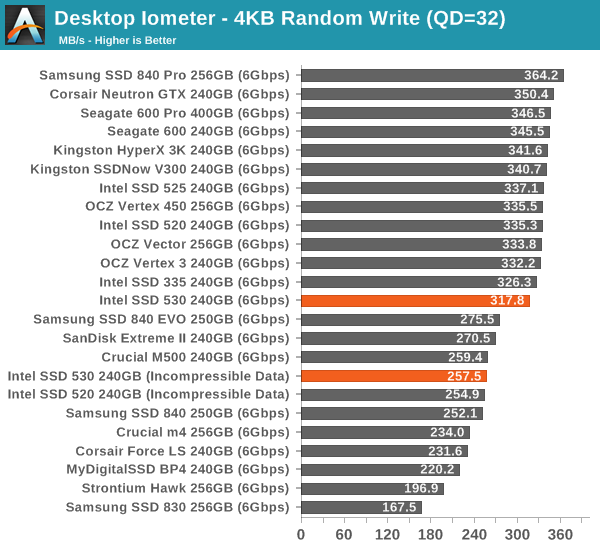
Random speeds are slightly down from SSD 520/525. The decrease could be NAND related as it's a fact that read and program times go up as we move to smaller lithographies, which will then translate to decrease in overall performance. However, compared to the SSD 335 performance is better but we're dealing with a higher bin of IMFT's 20nm NAND, so that's not a surprise.
Sequential Read/Write Speed
To measure sequential performance I ran a 1 minute long 128KB sequential test over the entire span of the drive at a queue depth of 1. The results reported are in average MB/s over the entire test length.
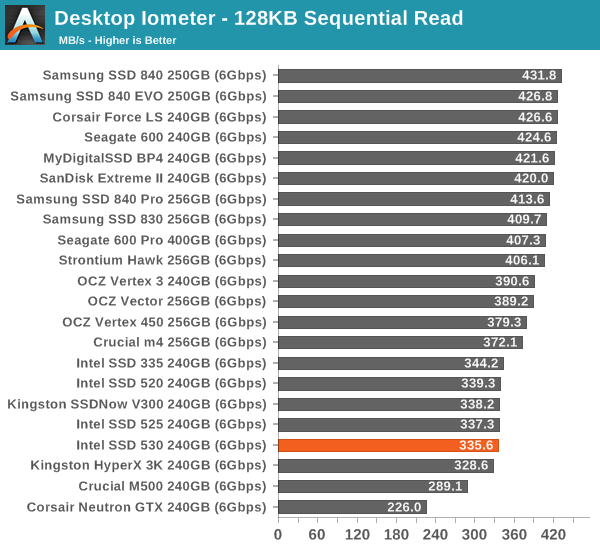
Read performance has never been one of SandForce's biggest strengths but write performance is top of the class (except when dealing with incompressible data).

AS-SSD Incompressible Sequential Read/Write Performance
The AS-SSD sequential benchmark uses incompressible data for all of its transfers. The result is a pretty big reduction in sequential write speed on SandForce based controllers.
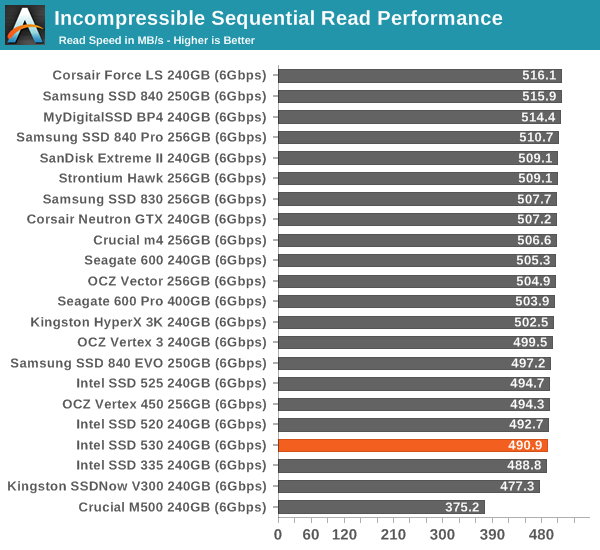
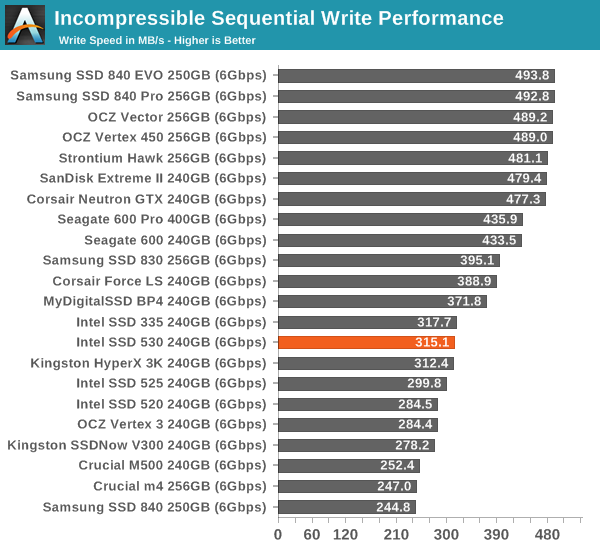










60 Comments
View All Comments
Magichands8 - Friday, November 15, 2013 - link
"It will be interesting to see what Intel's approach will be with SATA Express..."Apparently Intel's approach is to ignore it as SATA Express won't be a part of Intel's 9-series chipset to be released next year. So God knows when we'll have any reasonable access to it. It seems that the only place left for SSD makers to go in order to differentiate their products is to reduce price/increase capacity. And when SSDs finally start hitting 2+ TB per device at reasonable prices our only option will be to resort to RAID 0 to get around the SATA albatross hanging around our necks.
Hrel - Friday, November 15, 2013 - link
The Seagate 600 and Crucial M500 outperform the Intel drive and are a whopping $50 less. I see no value gained for paying more than $150 for a 256GB SSD. Am I missing something or is every 256GB drive over $150 as bad a deal as I think?Laststop311 - Sunday, November 17, 2013 - link
Samsung 840 pro is worth every penny. Not only does it consistently fall in the top 3 for sequential reads and random reads it also falls in the top 3 for lowest power used. It is the only ssd on the market to perform that high while using that low of wattage. It's something special and has reigned supreme the entire 14ish months it's been out.You really need to look for deals on it though. Like newegg is selling the 512GB for 480 but I went on ebay and found a brand new sealed in box for 389.00 free shipping and no tax. 480 is a lot of omney for a 512GB but for 389 at that deal how can you buy any other 500GB capacity drive. Also these samsung drives perform noticeably at their very best if you leave 20% of it untouched so out of the 512GB you really should leave 102GB free and just use 410GB. Thats why you should buy 1 capacity size over what you need so you can properly over provision and have maximum iops at all times.
I transfered a 200GB file from a 750GB samsung evo ssd to the 512GB 840 pro in a few seconds under 7 minutes. Thats pretty insane speed 200GB in less then 7 mins. Thats basically sata III being saturated. And it's saturates it while using the lowest power of ssd's in similiar situations.
So yes 240 dollars is a lot for 256GB but I have seen them go on sale for 190 and you can search ebay too. Don't settle for a cheap ssd with poor power efficiency and slower speeds.
purerice - Sunday, November 17, 2013 - link
I'm in the same boat you are. Seagate seemed to be near the top in most categories and used less power (perhaps over more time?) than Samsung 840 Pro and Intel... yet for a lot less money.For me especially, I'm still running on a 7200rpm drive for 90% of my work. The other 10% is 5400rpm. Even the slowest of these drives so so insanely faster than what I have that the marginal difference of anything above the Seagate gets lost in the wash.
MikeMurphy - Friday, January 10, 2014 - link
This isn't a top drive, but it offers good performance, all-important low idle power consumption, access to the extremely helpful Intel SSD Toolbox, Intel reliability and a 5-year warranty.I'm happy to spend a couple extra bucks for this feature set.
supax - Friday, November 15, 2013 - link
I actually just picked up a Seagate 600 240GB for $130 after $20 MIR. Seemed like a better deal to me anyway.jwcalla - Friday, November 15, 2013 - link
So is it confirmed that SF-22xx series drives work on Haswell chipsets? Is it only the SF-12xx series that doesn't work or is it still a mixed bag of guesswork?iwod - Friday, November 15, 2013 - link
I was just discussing this earlier. Since Intel decided to ditch the SATA Express, may be we are moving straight to PCI-E Native instead? The thing is we already have PCI-E Native SSD from Apple in many of its consumer Mac already already using it. And the trend will likely continue in next year. Since we are not going to get SATA Express until late next year with the original Intel 9 series chipset. Intel thought it may have been too late anyway and ditch it instead?Kristian Vättö - Sunday, November 17, 2013 - link
SATA Express is PCIe. SATA Express is simply the name of the connector which combines SATA and PCIe into one (i.e. the same connector works with SATA and PCIe devices).http://www.anandtech.com/show/6294/breaking-the-sa...
Morawka - Saturday, November 16, 2013 - link
The biggest fail of the year is when Asus put the M.2 Connector on a PCI 1.0 Bus. GG ASUS are you retarded?